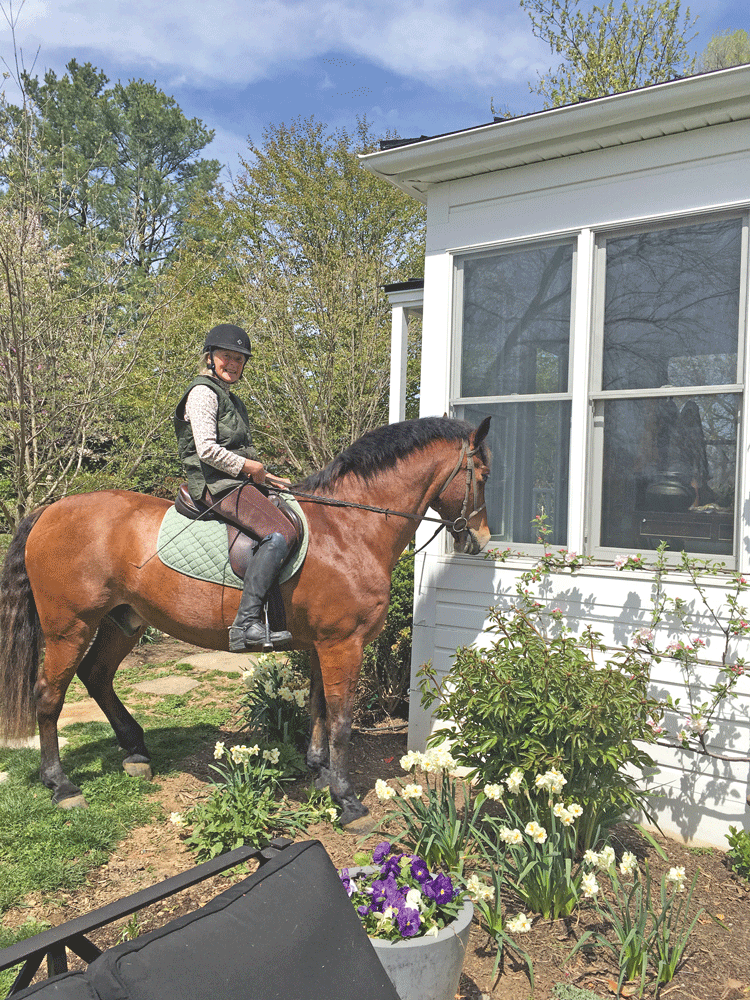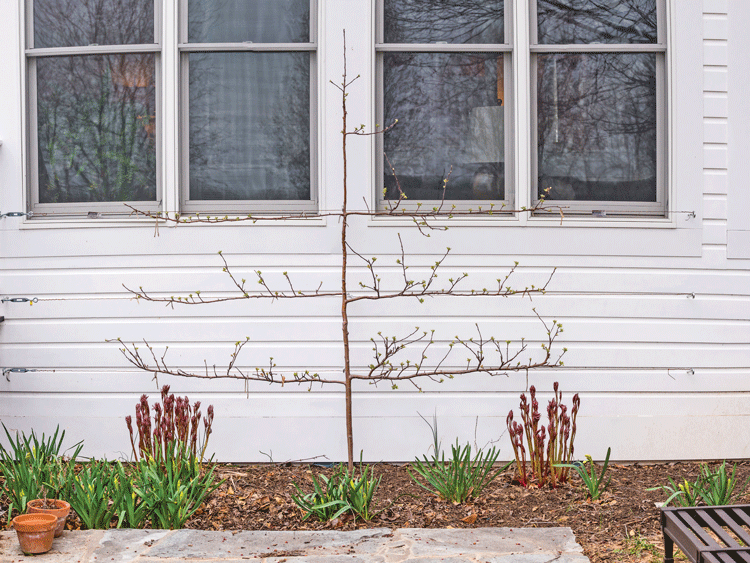Espalier: Ooh, La, La

By Ashley Bommer Singh

Vita Sackville-West became a celebrated garden columnist in the United Kingdom for her colorful and informative weekly garden columns in the Observer. In one piece from the early 1950s, Vita exhorted her readers to beautify their front gardens in time for the Festival of Britain.
She called for the planting of flowering trees, “the prunus, the pyrus, the Japanese cherries, the almonds” and training them horizontally from “your front gate to your front door” to let the sun shine through and not block the windows. This effect would create paths of blossoms from street to door throughout England’s villages. Planting flower beds to spruce up your front garden was adequate, according to Vita, but something more permanent, like these structured flowering trees, would be striking.
The technique of training flowering trees or shrubs to grow along wires into shapes on a flat plane is called espalier. Such painstaking control of tree growth dates back to the mid-1600s or earlier, particularly in France, where growers found it maximized fruit yields in harsh climates. Elaborate aesthetic forms were not far behind.
I have two young espaliered apple trees on the back, south-facing wall of my house, and they already provide permanent structure that is appealing year-round. They also provide food for the bees. I’ve adopted a traditional horizontal cordon with three tiers, and they grow along wires under my windows, with the trunk reaching and climbing just between. My son loves to be eye-level with the branches and blossoms and bees, and he will have fruit to pick this year or next. I love to see and smell the springtime apple blossoms peeking right into our sunroom windows.

George Washington had hundreds of espaliered trees at Mount Vernon. He used the technique to maximize fruit potential. Apples and pears were planted in rows to protect vegetable garden beds. These free-standing espaliers could be harvested from both sides of the tree. Stone fruits such as apricots, peaches, nectarines and cherries were espaliered along the interior stone walls, where their fruit ripened faster due to the warmth of the walls and protection from the elements.
Mount Vernon’s espaliers have inspired countless gardeners including Peter Thevenot of River Road Farms in Decatur, Tennessee. Starting with just 35 plants 25 years ago, River Road is now America’s largest provider of espaliered trees with thousands growing. They are even supplying Mount Vernon. My Blacktwig and Gala apple espaliers came from River Road with detailed notes from Peter. “I put years of work into each tree; they are like my children,” he wrote.
Although I, too, first noticed espalier at Mount Vernon 25 years ago, my inspiration for trying it at home came from the parking lot of Middleburg’s Red Fox Inn. Driving out you can see two lovely espaliers along a pale stucco wall. They give a sense of magic and mood (even next to a parking lot). These espalier flank the Inn’s “Middleburg House,” and if you walk the path behind the house, several more line the wall. Searching for something similar for the stark white back wall of our farmhouse led me to River Road.

Horizontal cordons, u-shaped cordons, candelabras, palmettos, tunnels and elaborate “Belgian fences” are all possible by training young shoots to grow in certain directions and pruning appropriately. Many fruit and flowering trees, including apple, pear, crabapple, plum, apricot and cherry, can be trained to grow in these shapes. Rose of Sharon lends itself to the form. Even magnolia, whose blossoms Vita likened to “great white pigeons settling among dark leaves,” can be trained. Freestanding espaliers, much like grape vines, should be north-south facing to allow as much light as possible. They need sturdy posts at each end to secure the wires, and the plants should not grow more than two yards high.
David Lohmann, owner of Abernethy & Spencer Greenhouses in Purcellville, Virginia, likes pear trees for espalier best. According to David, Asian pears do extremely well while peaches are difficult. The best way to start is with one- or two-year-old plants that are healthy and well-suited to your area and soil type. Around here, it is wise to choose varieties that tolerate humid Virginia summers. For a jump start, providers like River Road will sell you 3-year-old trees that come trained to their future shape, or even 6- to 8-year-old “estate” trees that are ready to impress.
Friends always comment on our espaliers, often in disbelief that they are apple trees. Some doubt the trees can actually be happy growing in this manipulated state. I hope they are content, for they give the garden a sense of permanence and elegance. “Ooh, la, la” my French friend Heloise quipped last weekend as she saw them in bloom for the first time.

The permanence and structure of espaliered trees are like a steady hand amid the dizzying flurry in the rest of the garden, especially in spring. This year daffodils and peonies, as well as more salvias, alliums and nepeta, are complimenting the espalier.
Of course there is an art to maintaining your espalier and coaxing it into the shape you want. You should feed and fertilize in the spring and inspect the leaves regularly for pests such as white flies, aphids and spider mites as well as diseases. Problems should be treated quickly. In addition, it is important to water in the summer heat at least in the early years. These are my first espaliered trees, so I am experimenting and learning.
The espalier lends a classic feel to the garden and a source of strength. Who wouldn’t want flower blossoms and then apples or pears or apricots at arm’s length? We may not have enough to supply Mt. Defiance for cider, but the espaliered apples out our back window supply plenty of joy. ML


